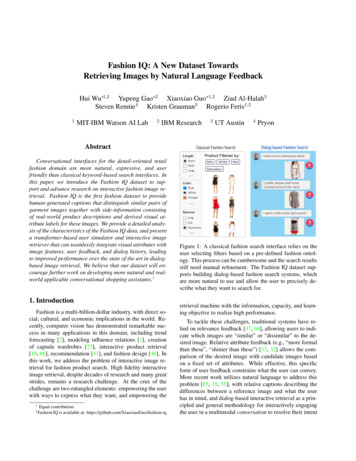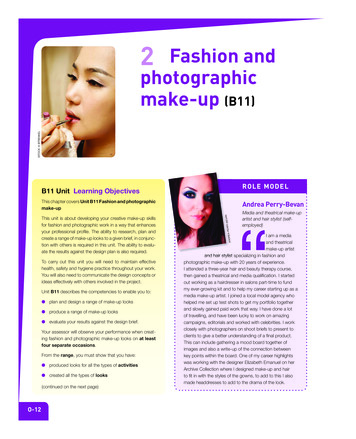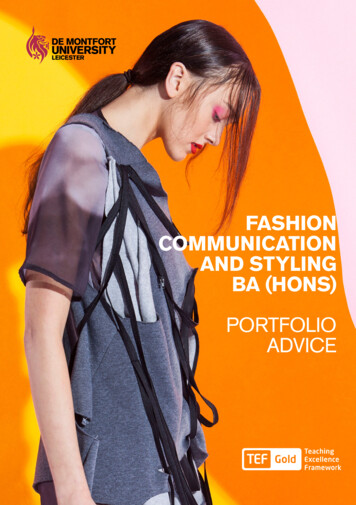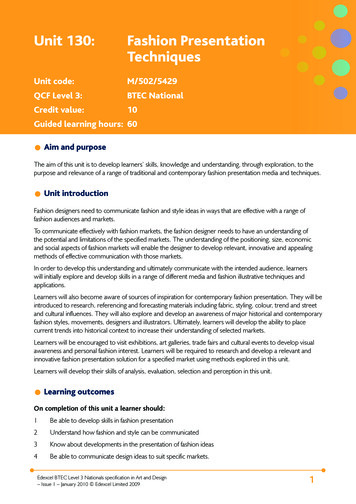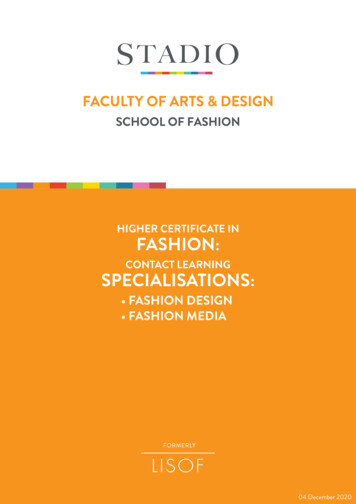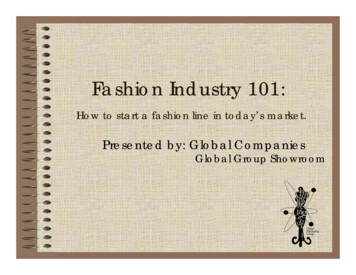
Transcription
Slow Fashion: Tailoring a StrategicApproach towards SustainabilityCarlotta Cataldi, Maureen Dickson, Crystal GroverSchool of EngineeringBlekinge Institute of TechnologyKarlskrona, Sweden2010Thesis submitted for completion of Master of Strategic Leadership towardsSustainability, Blekinge Institute of Technology, Karlskrona, Sweden.Abstract: This research explores one avenue for achievingsustainability within the fashion industry; which as it exists today isunsustainable. The Slow Fashion movement has an existing foundationin the larger fashion industry and is already making strides towardssustainability. The authors used this opportunity to examine a strategicapproach, as its current approach is ad hoc. First, the authors assessedthe Slow Fashion movement using the 5 level Framework for StrategicSustainable Development. To analyze the Slow Fashion movementfurther, the concept of Leverage Points was used to provide a focusedlens to assist the author’s in navigating through the fashion industry’scomplex system. Findings were synthesized into thirty strategicrecommendations that target various players in the Slow Fashionmovement. Three key recommendations will provide the most leveragein strengthening the Slow Fashion movement: 1) Co-create SlowFashion Principles to represent the values of the movement and a shareddefinition of sustainability 2) Establish an overarching global networkand local chapters for the Slow Fashion movement 3) Harmonize globalgarment and textile labelling initiatives under a Slow Fashion label.Keywords: Slow Fashion, Sustainable fashion, Strategic SustainableDevelopment, Slow Fashion Principles, Leverage Points, SlowMovements
Statement of CollaborationThis thesis is the result of an intense collaboration between Carlotta,Maureen and Crystal. Our professional backgrounds are very different,coming respectively from the worlds of fashion, sustainability and design.Each individual added depth and competence to the collective research. Allteam members joyfully dove into the project and undertook equal parts ofthe literature review, consistently supplying summaries to the rest of theteam and encouraging discussions and ideas for further exploration.Carlotta’s previous experience in the fashion industry gave the team accessto invaluable insight; she dug deeply into the details of our groupdiscussions to offer her understanding of complex concepts, and challengedresults and recommendations to ensure they were well thought out andunderstandable to our audience. Despite being the only non-native Englishspeaker, she also took great pleasure in correcting grammar and spellingmistakes throughout the paper. Maureen’s ability for designing surveys andorganizing results naturally elected her for this role. Thanks to her researchand writing skills she has also taken much responsibility in editing thepaper and ensuring clear, comprehensive and applicable results. Crystal, theteam’s IT, design and organizational genius, took care of perfecting everyimage in the thesis, the documents sent to external advisors, and the websitecreated for this occasion. She also led the way in effectively coordinatinggroup meetings, agenda’s and tasks.The process of analyzing the results and elaborating the recommendationsoften involved creative and exhausting brainstorms, but it always led us toreach consensus and a deeper overall understanding of the subject area.Overall, we recognize that writing a thesis in three is challenging but it hasbeen a priceless and enriching experience; we feel especially grateful forthe opportunity. We also hope that the collaboration that began during thisprogram and consolidated in the thesis period will continue well beyond theend of this project.Carlotta CataldiMaureen DicksonCrystal GroverKarlskrona Sweden, May 2010ii
AcknowledgementsFirst, we warmly thank our advisors Merlina Missimer and Zaida Barcena:their confidence, insight, professionalism and passion for our topicsupported and encouraged us throughout the thesis period. This projectwould look quite different without their guidance.A big thank you goes to all of the system thinkers, practitioners and expertsin sustainability who patiently read through our drafts or simply listened tous and provided invaluable feedback that helped us deepen our knowledgeand improve our project; a special thank you to Eric Ezechieli, SimonGoldsmith, Maura Dilley, and Ed Hanlon. Thanks also to the graduatesfrom the MA Fashion and the Environment at the London College ofFashion for sharing inspiring stories and projects with us. You helped usbegin our project with excitement and creativity. Great inspiration wassupplied by the works of Kate Fletcher, Donella Meadows, Otto VonBusch, Carl Honoré, Alistair Fuad Luke, Carolyn Strauss and notably KarlHenrik Robèrt.Carlotta: I would like to thank my family for constantly challenging me andsupporting all of my decisions and for giving me the opportunity to be hereand live this wonderful experience.Maureen:To my family, Danya and Ron, thank you for yourencouragement and open ears. Your support allowed me to chase after mydreams and realize my full potential.Crystal: Mom, Dad, and sisters; without your unwavering support and love,I would not have had this life changing opportunity. Josh, thank you forbeing my constant source of encouragement.A special acknowledgement goes to Ece, Wyeth, Matt L., Mark, Zach,John, Laura, Sophia, Giuliana, Elsa and Stepanka for giving us continuoussupport, insight, feedback and challenges to consider, while they were alsoworking on their own projects. Tack så mycket guys!Last but not least, our biggest thank you goes to our classmates, who havefilled our year with laughter, new learning and an unforgettable lifechanging experience.iii
Executive SummaryBackgroundFashion is an innate part of individual expression and it is a culturalreflection of a point in time. Although fashion plays a central role in oursociety, today’s industry– which is dominated by the globalized FastFashion industry – is contributing to the sustainability challenge.The fashion industry has begun to tackle some of the challenges byimplementing initiatives, however, the authors recognize that these actionsare tied to a system rooted in rising consumerism, which is beingconfronted with population growth, diminishing natural resources andclimate change. There has been an emergence of ethical, “eco” andsustainable fashion designers, brands and retailers. But overall, theconsumer awareness of the impacts of the fashion industry is quite low andsustainable fashion is still a niche market (Defra 2008).The Slow Fashion movement has been recognized as one avenue forachieving sustainability in the fashion industry. The slow approachencourages taking time to ensure responsible production; it adds value tothe garment through quality design and encourages contemplating itsconnection with the environment and the garment maker (Fletcher 2007;Honoré 2004). It is unique in that it includes the consumer in the supplychain, as a co-producer, to foster personal connections and an overallawareness of the production process. Slow fashion is based on the SlowFood movement in particular and other slow movements in general. It is anew model that aims to assemble eco, ethical and sustainable fashion intoone movement, in order to meet fundamental human needs, while allowingfor the earth’s natural regeneration to take place.Purpose and Research QuestionsThis thesis is intended to inspire a broad audience in the fashion industrybut it is specifically targeting Slow Fashion designers, brands, suppliers,buyers, manufacturers and retailers and co-producers. The overall researchaim is to strengthen the Slow Fashion movement by providing strategicguidance on how it can move towards a sustainable vision, rooted inscience. A primary research question has been developed and is supportedby three secondary research questions:iv
How can a Strategic Sustainable Development (SSD) approach be used tostrengthen Slow Fashion’s strategic move towards sustainability? What does the FSSD reveal about the Slow Fashion industry and itsmove towards sustainability?How can Leverage Points be used to strengthen Slow Fashion'scontribution to a sustainable society?Based on the above findings, what strategic recommendations canbe made to the Slow Fashion industry?MethodsThe research methods utilized an interactive approach to assess the SlowFashion movement. The authors drew on a conceptual framework basedon Strategic Sustainable Development. The research was continuallyadapted throughout the process as new information, perspectives andinsights surfaced. The conceptual framework included systems thinking, theFive Level Framework for Strategic Sustainable Development (System,Success, Strategic Guidelines, Actions, Tools), and key components ofSSD, such as the four Sustainability Principles and ‘backcasting’ fromfuture success (Holmberg et al. 2000).The concept of Leverage Points, developed by scientist and system-thinkerDonella Meadows, was also used to pin-point places to intervene in theFashion industry, and society at large, to create a system change in favor ofstrengthening the Slow Fashion movement.Research results were gathered in four phases. Phase one consisted of anassessment of Slow Fashion’s move towards sustainability using the FSSD,where particular focus was placed on the ‘System, Success, and StrategicGuidelines’ levels. At the Actions and Tools level, the authors acknowledgethat a variety of actions and tools, which are bringing the movementtowards sustainability have already emerged. A literature review andevidence from an industry survey provided the authors with a solidunderstanding of the current state of the Slow Fashion movement in relationto these five levels.Phase two reviewed each of the 12 Leverage Points that were currentlybeing used to strengthen the Slow Fashion movement, and the potentialbarriers and gaps preventing the success of each Leverage Point. Thereferences from the literature review in Phase one were used and filteredinto the analysis of the Leverage Points. Additionally, the industry surveyv
was a key source of information. Expert interviews also provided valuableinsight on a number of specific topic areas.Phase three determined the strategic recommendations for players in theSlow Fashion movement. Using the findings discovered during the first tworesearch phases, the authors conducted brainstorming sessions to developrecommendations that addressed both the Leverage Points and the FSSD.Phase four was an extension of one of the key recommendations developedin phase three: to co-create Slow Fashion Principles. It was recognized thatthis phase needed to be initiated and the principles were unearthed fromwhat is occurring within the Slow Fashion movement. To begin validatingand co-creating the principles, an expert panel of people working insustainable fashion, the slow movements and sustainability in generalprovided sound insight and feedback.ResultsPhase 1: FSSD. From our assessment using the FSSD, it is clear at theSystem level that the Slow Fashion players are aware of their connectionswith the natural environment and society – from the workers in the supplychain to the communities that they operate in. At the Success level, themovement does not have a common vision of future success, or a cleardefinition of sustainability. Therefore, at the Strategic Guidelines level, theSlow Fashion movement is not being strategic in its actions to achievesustainability and is unable to backcast from success. At the Actions andTools level, there are numerous sustainability initiatives occurring.Phase 2: Leverage Points. At the higher Leverage Points, the Slow Fashionmovement is creating buffers of more sustainable materials such as organiccotton, bamboo, hemp and flax. Also, all survey respondents wereinterested in sourcing more of these in the future, however they aregenerally more expensive. There is also a delay in increasing the supply ofrenewable fibres and developing natural dyes caused by technology andskill development barriers. Localized supply chains in addition to textileup-cycling, is supporting Slow Fashion material flows. But, it is still morecost-effective to source textiles from developing countries, and creatingnew supply chain structures is very challenging and time consuming.A positive-reinforcing loop, triggered by increased media, marketing andawareness can be used to increase the demand for Slow Fashion.Information flows can be a very effective point of intervention, especially,vi
if new information is being delivered on sustainability and the benefits ofSlow Fashion within the supply chain and to co-producers. But, there is alack of clear information on the sustainability impacts of the supply chain,and it is difficult to compare the fibres and dying processes. Slow fashiondesigners/brands are communicating information to co-producers, but theoverall awareness of Slow Fashion is still quite low and awarenesscampaigns are concentrated in only a few countries.Overall, there are not enough rules to limit pollution in the fashion supplychain, and enforcement is low – resulting in lower retail prices for FastFashion.Slow fashion producers are going above and beyondenvironmental standards, thus their prices are not as competitive. As well,organic and Fair Trade certifications and labelling schemes are tooexpensive and time consuming for small brands, and moreover theawareness of these eco-labels between co-producers is quite low.At the most influential Leverage Points, the Slow Fashion movement isbeginning to self-organize from grassroots initiatives, and innovative,forward-thinking small brands, but it still needs strategic organization tosucceed as an officially recognized movement. It relies on a diversity ofmaterials, ideas, business models and each business surveyed had differentgoals and purposes; however, an overarching theme of willing to contributeto a more sustainable society emerged from survey’s result.Lastly, Slow Fashion presents an alternative paradigm to the current fashionmodel by establishing new mental models in society that satisfyfundamental human needs, instead of market wants, while allowing for theearth’s natural regeneration to take place.Phase 3: Strategic Recommendations. Based on the findings in Phase oneand two, thirty short, medium and long-term strategic recommendationswere created to strengthen the Slow Fashion movement and to move ittowards sustainability. Each recommendation is targeted at a specific groupof Slow Fashion players and taps into one, or a combination of LeveragePoints. Of these, three key recommendations have been identified asbringing the most leverage the Slow Fashion movement: 1) Co-create avision of success for the Slow Fashion movement 2) Establish anoverarching Slow Fashion network 3) Harmonize global labellinginitiatives under a Slow Fashion garment label.Phase 4: Slow Fashion Principles. To initiate the first recommendation, tenprinciples for Slow Fashion have been discovered to begin this co-creationvii
process. They are intended to provide inspiration and guidance for SlowFashion players and those wishing to join the movement to contribute to asustainable society.DiscussionThe Slow Fashion Principles will be further co-created amongst thoseworking directly in the industry. Although individual businesses holdunique goals, it is understood that the overall purpose of the Slow Fashionmovement is to contribute to a sustainable society. By participating in theco-creation process, Slow Fashion players will connect to this greaterpurpose and to others that are working towards the same goal. As well,spreading the vision1 is a strategic step towards creating a shared mentalmodel and common definition of sustainability. The principles can beshared though existing online networks, community events and workshops.The Slow Fashion movement is addressing the Leverage Points discussedabove and using some of them very effectively, however, they may bedoing so unknowingly. These strategic recommendations are offered toassist Slow Fashion players to tap into their full potential, and addressbarriers and gaps, to strengthen the overall movement. The threerecommendations that will provide the most leverage will be challenging toachieve, however, it is recognized that they are the most strategic and willstrengthen the movement considerably. Overall, these recommendationswill require the utmost collaboration between individual designers and theirsupply chains, governments, certification bodies, NGOs and online hubsamong others. Overall, the increased interconnectivity of the movementwill allow for Slow Fashion to emerge as a vibrant, robust and trulysustainable fashion model for the future.ConclusionThe existing Slow Fashion movement has initiatives popping upworldwide. If these initiatives merge together in a strategic way, asproposed in this thesis, Slow Fashion could be the sustainable fashionmodel that helps society move toward sustainability.1The ten Slow Fashion Principles and the four Sustainability Principlesviii
GlossaryAnthropogenic: Human induced.Backcasting: ‘Planning from success’ by starting with the desired futureand asking ourselves “what do we need to do to get from here to there?”Balancing Feedback Loop: A stabilizing feedback loop, also known as a“negative feedback loop”. It balances the direction of system change.Consumer: See co-producer.Co-producer: An end-user in the supply chain. This term will be usedinstead of ‘consumer’ in this report, as it is acknowledges that the end usersare deeply involved in the production process; by including them in thesupply chain, it also includes them in sharing responsibility and gives themaccess to transparent information.Eco/sustainable/ethical fashion industry: Different terms for an industrythat manufactures clothing using environmentally friendly processes(upcycling, recycling, local fabrics, locally production, natural fabrics anddyes, inspiration drawn from nature), organic textiles (i.e. hemp) and non–textile materials (i.e. bamboo or recycled plastic bottles).Fashion industry: This industry includes farmers, clothing manufacturersand suppliers, buyers, retailers, consumers and co-producers. Itencompasses all types of fashion production, from Fast to Slow Fashion.Fast Fashion: Clothing industry focused on low cost mass-production. It issold by retailers at very low prices and is based on the latest trends, whichencourages consumers to purchase more than they need resulting inexternal environmental and social impacts.Framework for Strategic Sustainable Development (FSSD): Refers tothe five-level framework that has been adopted to plan strategically towardssustainability within the system “Society within the ecosphere”. The fivelevels are: System, Success, Strategic Guidelines, Actions and Tools.Living Wage: Where the earnings from a standard working week aresufficient to meet the basic needs of workers and their dependence. This istypically higher than a set minimum wage (Baldwin and Williams 2008).ix
Multi-local: Where “global” is made up of a network of “local systems” ofalternative initiatives with common characteristics. Whatever is locallyavailable is used to best advantage and whatever cannot be produced locallyis exchanged and shared, giving rise to a society and an economy that is atthe same time both local and cosmopolitan (Slow Design 2006).Organic: Raw materials that have been grown without the use of pesticidesand are certified by a third party. The term organic can be solely referred tothe source of raw materials, not to the processes the fibre then undergoes.Production: Includes the entire supply chain from farmer to co-producer.Raw material: A natural, unprocessed material used in a manufacturingprocess.Reflective Consumption: A term utilized in Slow Design that meansreflecting about the utility of a product to ensure that the purchase is reallyneeded.Reinforcing Feedback Loop: An amplifying/enhancing feedback loop,also known as “positive feedback loop”. It reinforces the direction ofsystem change. These are both vicious cycles and virtuous cycles.Slow Fashion: A decelerated fashion movement. In this paper the termSlow Fashion represents a more compact and strategic model for theeco/sustainable/ethical fashion industry. Pivotal to the Slow Fashionmovement is the co-participation of the consumer in the supply chainallowing people to satisfy their fundamental human needs while notcontributing to the systematic degradation of the ecosphere.Sustainability Principles: Refers to basic principles for socio-ecologicalsustainability to define the minimum requirements of a sustainable society.System: A set of elements or parts that are organized and interconnectedthat produces a characteristic set of behaviours.Systems Thinking: A scientific discipline which looks at the whole ratherthen analyzing the different parts of a system. It helps understand complexproblems.x
Vertically Integrated: Form of business organization where all stages ofproduction of a good, from the acquisition of raw materials to the retailingof the final product, are controlled by one company.xi
AcronymsCSR: Corporate Social ResponsibilityDEFRA: UK Department for Environment, Food and Rural AffairsEJF: Environmental Justice FoundationEFF: Ethical Fashion FoundationETI: Ethical Trading InitiativeEU: European UnionFSSD: Framework for Strategic Sustainable Development, also known asthe TNS Framework for strategic planning towards sustainability.GMO: Genetically Modified OrganismGOTS: Global Organic Textile StandardIPCC: Intergovernmental Panel on Climate ChangeNGO: Non-Governmental OrganizationREACH: Registration, Evaluation, Authorization, and restriction ofChemical substancesSSD: Strategic Sustainable DevelopmentTNS: The Natural Step, an international NGO of Swedish origin thatdeveloped and promotes the FSSD.xii
Table of ContentsStatement of Collaboration. iiAcknowledgements . iiiExecutive Summary .ivGlossary .ixAcronyms . xiiTable of Contents. xiiiList of Figures .xv1Introduction.11.1 What is Fashion and why does it exist?.11.1.1 Fashion and Culture .11.1.2 Fashion and Human Needs .11.2 Today’s Fashion Industry.21.2.1 The Sustainability Impacts.41.2.2 The Sustainability Challenge .51.2.3 Sustainability Improvements to-date .61.3 Slow Fashion: towards a Sustainable Fashion Industry.71.4 Research Purpose .91.5 Scope.91.6 Research Questions .101.7 Assumptions and Limitations.102Methods.112.1 Research Design .112.2 Conceptual Framework .112.2.1 Framework for Strategic Sustainable Development (FSSD) .112.2.2 Leverage Points.142.3 Research Methods .142.3.1 Phase 1 .152.3.2 Phase 2 .152.3.3 Phase 3 .172.3.4 Phase 4 .172.3.5 Networking .183Results .193.1 Phase 1: FSSD.193.2 Phase 2: Leverage Points .223.2.1 12. Constants, parameters, and numbers.223.2.2 11. Buffers: size of stabilizing stocks relative to their flows.23xiii
3.2.3 10. The structure of material stocks and flows . 243.2.4 9. Delays. 263.2.5 8. Negative feedback loops . 273.2.6 7. Positive feedback loops. 283.2.7 6. The structure of information flows . 293.2.8 5. Rules: punishments, constraints, incentives. 323.2.9 4. The power to change or self-organize system structure. 343.2.10 3. System goals . 363.2.11 2. The mindset the system arises from . 363.2.12 1. Transcending paradigms . 373.3 Phase 3: Strategic recommendations . 383.3.1 Recommendation 1: Co-create Slow Fashion Principles . 413.3.2 Recommendation 2: Slow Fashion Network . 413.3.3 Recommendation 3: Slow Fashion label. 433.4 Phase 4: Slow Fashion Principles. 444Discussion . 504.14.24.34.44.54.64.75The goal of the Slow Fashion system . 50Co-creating a vision. 51Backcasting from Sustainability Principles . 52Leverage Points. 54Moving the recommendations forward . 55Limitations and Validity . 57Suggestions for further research. 58Conclusion . 60Cited references. 61Additional references. 67Appendices. 71Appendix A: Initiatives, NGO’s and Education . 71Appendix B: Online Networks and Industry Magazines . 74Appendix C: Slow Fashion Designers . 75Appendix D: Experts, Thesis Reviewees, Interviewees . 79Appendix E: Labelling Initiatives . 81Appendix F: Survey Results. 82xiv
List of FiguresTable1.1. 9 Basic Human Needs (Max-Neef 1991).2!Figure 1.1. Co-Producer Definition.3!Figure 1.2. The Funnel Metaphor .6!Figure 2.1. Interaction Model for Research Design. .11!Figure 2.2. The FSSD.12!Figure 2.3. Sustainability Principles.12Figure 2.4. Leverage Points.14!Figure 2.5. Research Phases and Methods .14!Figure 3.1. The System.19!Figure 3.2. Sustainability Quotes .21!Figure 3.3. Case Study: Remade in Leeds.26!Table3.1. Recommendations.
The Slow Fashion movement has an existing foundation in the larger fashion industry and is already making strides towards sustainability. The authors used this opportunity to examine a strategic approach, as its current approach is ad hoc. First, the authors assessed the Slow Fashion
